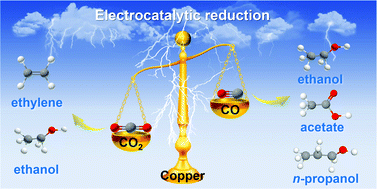Electrocatalytic reduction of CO2 and CO to multi-carbon compounds over Cu-based catalysts
Abstract
The electrocatalytic reduction of CO2 with H2O to multi-carbon (C2+) compounds, in particular, C2+ olefins and oxygenates, which have versatile applications in the chemical and energy industries, holds great potential to mitigate the depletion of fossil resources and abate carbon emissions. There are two major routes for the electrocatalytic CO2 reduction to C2+ compounds, i.e., the direct route and the indirect route via CO. The electrocatalytic CO2 reduction to CO has been commercialised with solid oxide electrolysers, making the indirect route via CO to C2+ compounds also a promising alternative. This tutorial review focuses on the similarities and differences in the electrocatalytic CO2 and CO reduction reactions (CO2RR and CORR) into C2+ compounds, including C2H4, C2H5OH, CH3COO− and n-C3H7OH, over Cu-based catalysts. First, we introduce the fundamental aspects of the two electrocatalytic reactions, including the cathode and anode reactions, electrocatalytic reactors and crucial performance parameters. Next, the reaction mechanisms, in particular, the C–C coupling mechanism, are discussed. Then, efficient catalysts and systems for these two reactions are critically reviewed. We analyse the key factors that determine the selectivity, activity and stability for the electrocatalytic CO2RR and CORR. Finally, the opportunities, challenges and future trends in the electrocatalytic CO2RR and CORR are proposed. These insights will offer guidance for the design of industrial-relevant catalysts and systems for the synthesis of C2+ olefins and oxygenates.



 Please wait while we load your content...
Please wait while we load your content...